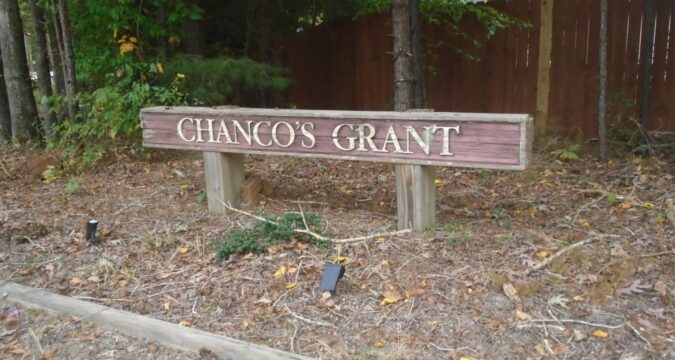
Residents of the Williamsburg area are lucky to have history all around them — not just in the major historical sites but in the names of local communities and roadways. Few neighborhoods illustrate this as well as the secluded community of Chanco’s Grant, which is located off Ironbound Road in James City County.
The name of the neighborhood is historic in its own right. The story of Chanco, the Native American boy who purportedly saved the Jamestown settlement from an attack on May 22, 1622, is generally well-known to local history buffs. He had been dispatched by tribal leaders to kill white settlers in the area south of the James River. Instead, he warned Richard Pace and other settlers that local tribes were planning an attack.
Under cover of darkness, Pace rowed to the Jamestown side of the river and delivered the warning that saved the settlement from total destruction, although the attack did kill about one-third of the population.
The main street that winds through the community is William Bedford — named for an early settler of Jamestown. Bedford was born in England and came to Virginia in 1621, when he settled in Jamestown. Not much is known about him, although his name appears on the Lists of the Living & Dead in Virginia compiled on Feb. 16, 1623, after the attack and the massacre that resulted despite the efforts of Chanco and Pace.
James Fort in 1607, when it became the first English settlement in North America. Getty Images
The first street that crosses William Bedford is Robert Hunt. This is the general naming pattern for this subdivision; the street names are not followed by a designation (such as street, drive, lane or way), and the cross streets are all designated as north or south following the street name. This street is named for Robert Hunt, the chaplain of the expedition that founded Jamestown in 1607. In 1606, the archbishop of Canterbury recruited Hunt to serve as chaplain for the Jamestown expedition. He sailed on the ship Susan Constant, captained by Christopher Newport.
On June 21, 1607, Hunt celebrated the first known service of Holy Communion in what is today the United States. He died the following year, and his remains are buried in the chancel of the historic church at Jamestown.
The second cross street is Richard Pace. Pace came to Virginia with his wife Isabella in 1618, and he was granted title to 400 acres of land on the south side of the James River about four miles upriver from Jamestown. He called this land “Pace’s Paines.” After the April 1622 attack on Jamestown, the Council in Virginia did not describe the actions of Chanco or Pace when it wrote to the London Company to give them news of the disaster. However, a subsequent letter from George Sandys, the colony’s treasurer, gave more detail, including the story of Chanco and Pace.
Although Pace and his family lived inside Jamestown’s walled fortifications for a while after the attack, they were granted permission to return to their land in the winter of 1622-23.
The third cross street is Richard Buck. Buck was also a minister, succeeding Hunt in 1608 and later serving as chaplain of the Virginia General Assembly. This body met at the church at Jamestown on July 30, 1619, as the first elected assembly and lawmaking body in colonial America. Buck and his family had sailed for Jamestown in 1609 on the ill-fated ship Sea Venture, which was shipwrecked off the coast of Bermuda and thus was significantly delayed in arriving in Virginia. Buck arrived at Jamestown during the 1610 Starving Time, when only 60 of the previous 500 colonists survived the harsh winter.
The fourth cross street is labeled Richard Grove, but this is almost certainly an incorrect transcription of a name. Although there is no person named Richard Grove on any documents connected to Jamestown, there is someone named Richard Graves. One source lists someone by that name as a passenger to Virginia between 1607 and 1624, another source lists him as a soldier in the Jamestown garrison in 1607-1608 and a third source names him as one of the survivors of the 1610 Starving Time.
The fifth cross street is Francis Chapman, name for a man who came to Virginia in 1608 (or 1611 — the records are uncertain) and was living in Jamestown in 1624. In 1625 he moved across the river to live on 100 acres of land in Paces Paines, adjacent to Pace’s property. In addition, the 1624-25 Jamestown Muster Roll includes a listing for Francis Chapman living in Paces Paines.
The sixth and last cross street is John Proctor, named for a settler who also came to Virginia aboard the Sea Venture in 1609-10 (along with Buck). He was granted about 100 acres of land south of Richmond in modern-day Chesterfield County and married Alice (or Allis) in 1622. The story of what happened to them at the time of the 1622 massacre is well documented. John was probably in England at the time of this attack, and Alice held off attackers at their isolated property until she could safely be moved to the fort at Jamestown.
After John’s return, they also settled near Pace’s Paines. John and Alice had several indentured servants, and they were accused of abusing — and possibly murdering — these servants in 1624. There is no record of the verdict in this case. John and Alice are of particular interest to me because they are my 10th great-grandparents.
Karen McPherson is a retired teacher, volunteer at Literacy for Life and instructor at the Osher Lifelong Learning Institute at William & Mary. She can be reached at kamcpherson168@gmail.com.
https://www.pilotonline.com/2025/10/28/you-can-learn-about-jamestown-in-chancos-grant/